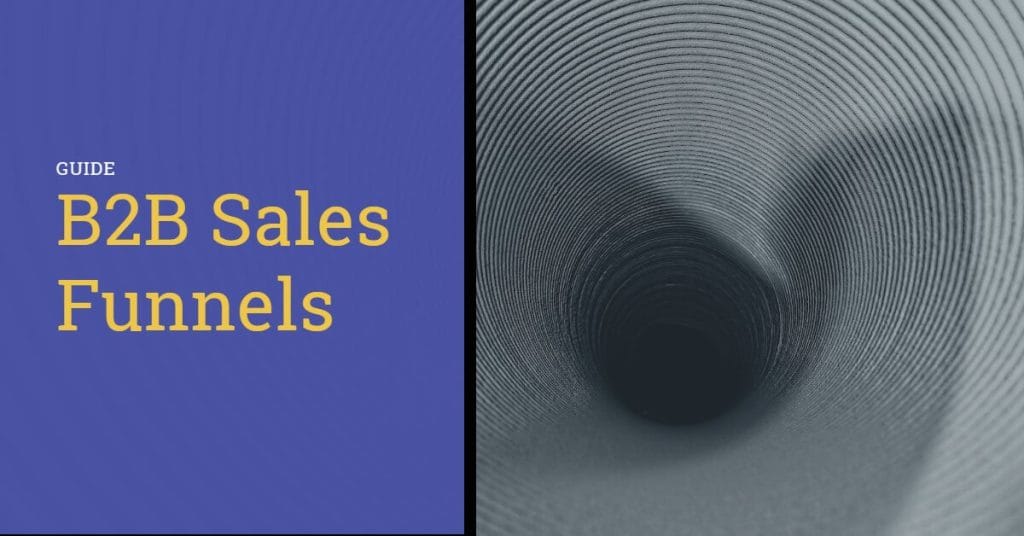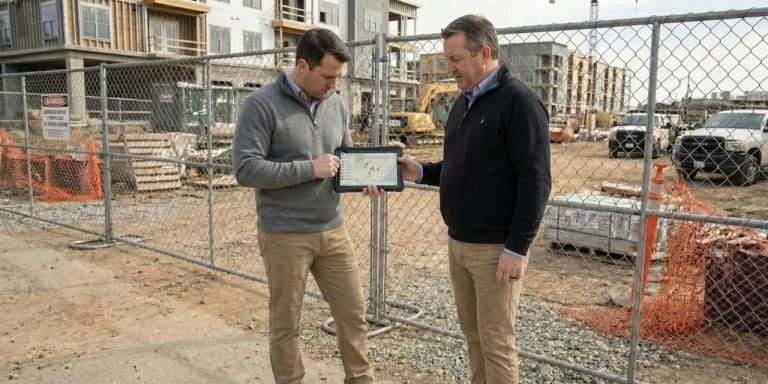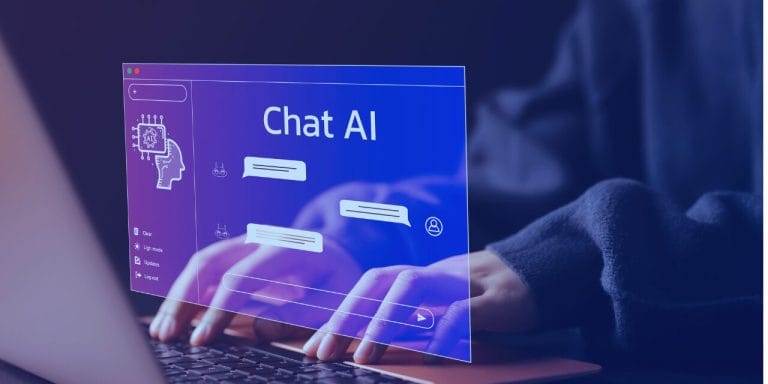Every B2B company wants the same thing: more sales.
Of course, wanting more sales and actually generating them are two different things. Fortunately, the B2B sales funnel is here to help you close more deals in less time!
In this article, we’ll explain what a B2B sales funnel is and how it differs from the standard B2C sales funnel. Then we’ll talk about why your company needs a B2B sales funnel, the six stages every funnel should have, and eight simple steps you can use to create one.
What is a B2B Sales Funnel?
A B2B sales funnel is a sequence of stages B2B buyers go through to become customers.
B2B sales funnels are often product-specific. But almost every one of them follows some version of the AIDA model, which stands for Awareness, Interest, Desire, and Action.
It’s important to remember that the typical B2B buyer will not progress straight through your funnel. They’ll move up and down; closer to a sale, then farther away; until they finally make a purchasing decision. This is perfectly normal and shouldn’t deter you in any way.
One more thing: there is a distinct difference between the B2C and B2B sales funnels. Namely, most B2C sales funnels are shorter than their B2B counterparts. This is because B2C funnels are often less complex than B2B ones, which shrinks the sales cycle.
B2C sales funnels, for example, don’t always require case studies, white papers, video testimonials, and live demos. B2B sales funnels, on the other hand, almost always do.
Why Do B2B Businesses Need A Sales Funnel?
Customer journeys are complicated—especially in B2B scenarios.
According to Gartner, the average B2B buying process involves “six to 10 decision-makers, each armed with four or five pieces of information they’ve gathered independently.”
Because of this, B2B sales departments need to take a strategic approach to sales. In other words, they need to create a reliable B2B sales funnel that sales reps can follow to convert prospects into paying customers. That’s the only way to achieve sustained success.
We’ll show you how to create a B2B sales funnel in just a minute. But first, we need to explain the difference between a funnel and a pipeline, as understanding this is crucial.
Sales Funnels Are Not Pipelines
The terms “sales funnel” and “sales pipeline” are often used interchangeably. The truth is, these are two different things that shouldn’t be mistaken for each other.
A sales funnel is a series of stages potential customers go through, as we discussed above. (Note: we’ll talk about the six stages your B2B sales funnel should have in the next section.)
A sales pipeline is a series of stages that sales reps go through to lead their prospects to a sale. Put another way, a sales pipeline represents a company’s sales process.
While these two terms are definitely different, they do have a lot in common. Their various stages even correlate with each other. The “Interest” stage of the sales funnel, for example, is directly related to the “Qualification” stage of a standard B2B sales pipeline.
6 Stages Of The Modern B2B Sales Funnel
So, what does an actual sales funnel look like? Great question!
These days, there are six B2B sales funnel stages you need to know about: Awareness, Interest, Evaluation, Decision, Purchase, and Retention. Let’s take a closer look at each.
Awareness
“Awareness” is the first stage in the B2B sales funnel.
This is when potential customers become aware of your brand for the first time. They probably won’t know about the products and/or services you sell yet. But they’ll start to build a relationship with your company as a whole, which can be exploited in the future.
Marketing teams have long owned the “Awareness” stage. But thanks to social media, B2B sales departments can now get in on the action, too.
Typical “Awareness” Stage Content: To connect with prospects in the “Awareness” stage, create and publish content like blog articles and social media posts.
Interest
“Interest” is the second stage in the B2B sales funnel.
This is when potential customers begin to develop an interest in the products and/or services you sell. They aren’t ready to buy from you at this stage. But they are ready to learn more about your offerings and how said offerings can help them solve specific problems.
Generally speaking, marketing teams own the “Interest” stage, too. But that doesn’t mean your sales reps can participate—or even handle it themselves if/when necessary.
Typical “Interest” Stage Content: To connect with prospects in the “Interest” stage, create and publish content like blog posts, email campaigns, webinars, and ebooks.
Evaluation
“Evaluation” is the third stage in the B2B sales funnel.
This is when potential customers get serious about purchasing the kind of product or service you sell—and officially become qualified leads. Folks in this funnel stage spend their time evaluating different solutions to decide which will meet their unique needs.
Both marketing and sales teams should have a hand in “Evaluation,” partnering to present their company’s products and/or services in the best possible way.
Typical “Evaluation” Stage Content: To connect with prospects in the “Evaluation” stage, create and publish content like email campaigns, case studies, and free product trials.
Decision
“Decision” is the fourth stage in the B2B sales funnel.
This is when potential customers buckle down and decide which product/service they want to spend their hard-earned money on. They’ve typically narrowed their choices down to a few options. If your company is one of them, you’re in good shape.
B2B sales teams should own the “Decision” stage, using the respect and authority they’ve earned during the sales process to influence prospects in a positive way.
Typical “Decision” Stage Content: To connect with prospects in the “Decision” stage, create and publish content like video testimonials, case studies, and discount offers.
Purchase
“Purchase” is the fifth stage of the B2B sales funnel.
This is when potential customers finally pull the trigger and become paying customers. It’s an incredibly exciting time—especially in B2B sales, which have notoriously long sales cycles.
B2B sales teams own the “Purchase” stage as well. Their goal should be to make the buying process as simple as possible, removing as much friction as possible.
Typical “Purchase” Stage Content: To connect with prospects in the “Purchase” stage, create and publish/distribute content like video testimonials and onboarding plans.
Retention
“Retention” is the sixth stage of the B2B sales funnel.
This when existing customers decide if they want to keep paying for specific products and/or services. It’s incredibly important, as studies show that a 5% bump in customer retention can boost company profits by an astounding 25% to 95%. Amazing!
“Retention” should be handled by both sales and customer support teams. These departments should work together to ensure quality customer experiences.
Typical “Retention” Stage Content: To connect with prospects in the “Retention” stage, create and distribute content like onboarding processes and product training manuals.
How to Create A B2B Sales Funnel
Okay, it’s time to create a sales funnel for B2B purposes. Don’t worry; it’s not all that hard. Just follow the eight-step process below, and you’ll be well on your way.
Define your overarching goals
First, decide what you want your B2B sales funnel to achieve.
Are you just looking to close more deals? Or do you want to improve specific metrics, like your sales team’s conversion rate, average sale value, and number of repeat sales?
The only wrong answer is no answer. So, before you do anything else, pick a few goals. Then choose a KPI or two to measure them. This will help you optimize your team’s performance.
Identify your ideal customer profile (ICP)
Next, take a moment to understand the people your company sells to.
Who are you targeting? What goals do they have? What challenges do they need to overcome? How can your company’s products and/or services help them do that?
Answering these kinds of questions will help you create an ideal customer profile (ICP), i.e., a fictional company that can benefit from the products/services you sell.
Once you have an ICP, you can use it to streamline your prospecting efforts. You’ll never have to wonder, “Is this company a good fit for our products?” You’ll just compare them to your ICP and know the answer, which will greatly improve your team’s productivity and performance.
The easiest way to create an ICP is to study your current customers. What do they have in common? Then assemble the information you uncover into a template.
Map out the buyer process
How do you turn complete strangers into paying customers? It’s an essential question that your sales department needs to answer for itself. If it doesn’t, you won’t close many deals.
Fortunately, by answering these six questions first, you’ll be able to answer it with ease:
- How many people are usually involved in the buying process?
- How can my sales reps connect with these people on a consistent basis?
- How can my sales reps build lasting relationships with key decision-makers?
- How many customer touchpoints do we need to design to generate a sale?
- What specific challenges do our products and/or services help customers overcome?
- What end result do our products and/or services help our customers achieve?
Answer these questions honestly, and you’ll learn how to turn strangers into customers. When that happens, you can build a B2B sales funnel that includes all of the necessary stages.
Identify your sales channels
Now it’s time to decide which channels you’ll use to connect with your ideal customers.
There are a bunch of channels available to you: in-person visits, cold calls, email and text sequences, social media networks, content marketing, and search engine optimization (SEO).
Here’s the good news: you don’t have to choose just one channel. In fact, you shouldn’t. Different customers connect with companies in different ways. The more channels you use, the wider net you cast, which often leads to more opportunities and, eventually, sales. That said, only invest in channels that your sales team can realistically and competently use.
When you know which channels you’ll use to reach your target audience, assign them to different stages of your funnel. Here are a few B2B sales funnel examples:
- The “Awareness” Stage: Cold call leads to introduce them to your company.
- The “Interest” Stage: Host webinars to help your target audience solve a problem.
- The “Evaluation” Stage: Craft email sequences to promote your company’s offerings.
- The “Decision” Stage: Send your prospects case studies to prove product viability.
- The “Purchase” Stage: Make onboarding plans via phone with potential customers.
- The “Retention” Stage: Visit customers in person to ask how they like your products.
Aligning marketing and sales teams
The best B2B sales funnels are implemented by sales and marketing teams.
When these departments are aligned, Marketing attracts the right leads and creates the right content, while Sales delivers said content at the right times and closes more deals.
Every company knows it needs to align its marketing and sales teams. Unfortunately, many of them never achieve this goal. Your organization needs to be different—at least if it wants to build an effective funnel that allows reps to make sales at a consistent pace.
Create enablement content for each stage of the funnel
While we’ve already touched on sales enablement content in this article, the topic deserves its own section. That’s how important it is. Fortunately, you’ve worked hard to align your sales team with your company’s marketing department. So they can help you craft these materials.
What kind of materials are we talking about? Blogs, social media posts, ebooks, and white papers, case studies, customer testimonials, customer training videos, and the like.
Once you start creating content (or get Marketing to create it for you), map it to different stages of your B2B sales funnel. Blogs and social media content are usually best for the top of the funnel, while case studies and training videos are usually reserved for the bottom.
Follow up and nurture
As mentioned above, B2B sales are complex. They hardly ever close on the first call. Or the second, third, or fourth calls. The reps that find success have mastered the follow-up process.
Luckily, following up is super easy in 2023. All you have to do is program your sales engagement or CRM app of choice to remind you to do it. Or, even better, craft drip campaigns to contact prospects automatically at appropriate intervals. Speaking of which…
Automate where you can
Your reps have a lot of their plates. You can help them out by investing in marketing and sales automation tools. Doing so will minimize the data entry tasks they’re forced to complete while also giving them the ability to schedule emails and text messages to send at ideal times.
One of the best automation tools for field sales teams is SPOTIO.
Use our platform to automatically capture contact details, communicate with prospects, schedule reminders, and generate reports. And that’s on top of the lead generation, territory management, route planning, and sales tracking features that are available.
Final Thoughts
Your B2B sales funnel is essential to the success of your company’s sales department. The good news is, you now know exactly how to build one—just follow the eight steps above.
As long as you define your goals, identify your ideal customer profile, map out your brand’s unique buying process, choose the right sales channels, and implement the other tips, tricks, and best practices we talked about in this article, you will succeed.
Just remember, succeeding is way easier with the right tools. For field sales teams, the “right tool” is SPOTIO. Why? Because it was specifically made for field sales purposes and had the features you need to both build and automate your B2B sales funnel.
Get a free demo of SPOTIO to discover everything our industry-leading platform can offer!




